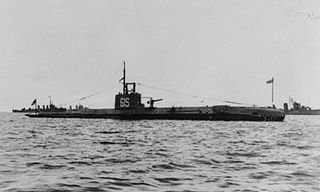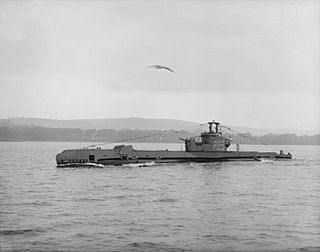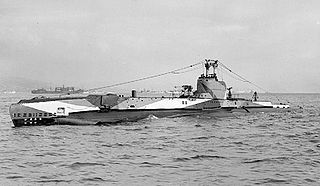
HMS A3 was an A-class submarine built for the Royal Navy in the first decade of the 20th century. She sank in 1912. The wreck is a Protected Wreck managed by Historic England.

HMS Grampus (N56) was the lead ship of her class of mine-laying submarine of the Royal Navy. She was built at Chatham Dockyard and launched on 25 February 1936. She served in World War II off China before moving to the Mediterranean Sea. She was sunk with all hands by the Regia Marina on 16 June 1940.

HMS Seahorse was a first-batch S-class submarine built for the Royal Navy during the 1930s. Ordered in March 1931, she was laid down at Chatham Dockyard in September 1931 and launched on 15 November 1932.

HMS Swordfish (61S) was a first-batch S-class submarine built for the Royal Navy during the 1930s. Commissioned in 1932, she was given the pennant number 61S and was assigned to the 2nd Submarine Flotilla.
HMS L10 was a L-class submarine built for the Royal Navy during World War I. The boat was sunk in 1918 by German torpedo boats.

HMS Salmon was a second-batch S-class submarine built during the 1930s for the Royal Navy. Completed in 1935, the boat fought in the Second World War. Salmon is one of twelve boats named in the song "Twelve Little S-Boats".

HMS Starfish was a first-batch S-class submarine built for the Royal Navy during the 1930s. Completed in 1933, she participated in the Second World War.

HMS Simoom was a third-batch S-class submarine built for the Royal Navy during World War II. She was laid down on 14 July 1941 and launched on 12 October 1942.

HMS Seneschal was a S-class submarine of the third batch built for the Royal Navy during World War II. She survived the war and was sold for scrap in 1965.

HMS Spur was a S-class submarine of the third batch built for the Royal Navy during World War II. She survived the war and was sold to Portugal in 1948.

HMS Spark was a S-class submarine of the third batch built for the Royal Navy during World War II. She survived the war and was scrapped in 1950.

HMS Sterlet was a second-batch S-class submarine built during the 1930s for the Royal Navy. Completed in 1938, the boat fought in the Second World War. The submarine is one of the 12 boats named in the song Twelve Little S-Boats. Thus far she has been the only ship of the Royal Navy to be named Sterlet.

HMS Sealion was a second-batch S-class submarine built during the 1930s for the Royal Navy. Completed in 1934, the boat fought in the Second World War.

The second HMS Talisman (N78), and the first to enter service under the name, was a T-class submarine of the Royal Navy. She was laid down by Cammell Laird & Co Limited, Birkenhead and launched on 29 January 1940.

HMS Thistle (N24) was a T-class submarine of the Royal Navy. She was laid down by Vickers Armstrong, Barrow and launched in October 1938. She was sunk by the German submarine U-4 on 10 April 1940 near Skudenes.
HMS Union was a British U class submarine, of the second group of that class, built by Vickers Armstrong, Barrow-in-Furness. She was laid down on 9 December 1939 and was commissioned on 22 February 1941.
HMS L24 was a L-class submarine built for the Royal Navy during World War I. The boat was not completed before the end of the war and was sunk in an accidental collision in 1924.

HMS P222 was a third-batch S-class submarine built for the Royal Navy during World War II. Commissioned in 1942, the boat had an uneventful first war patrol in the Alboran Sea. She intercepted the Vichy French merchant ship SS Mitidja in July, then provided protection for an Allied convoy to Malta in Operation Pedestal the next month. The navy intended that she was to be sighted on the surface by enemy aircraft to discourage potential attacks by surface warships. Though P222 did not encounter enemy forces, the convoy arrived at its destination on 15 August after sustaining severe losses. She then reconnoitred along the coast of Algeria in advance of Operation Torch, and was attacked by a French patrol ship, but sustained no damage.

HMS Pandora was a British Parthian-class submarine commissioned in 1930 and lost in 1942 during the Second World War. This class was the first to be fitted with Mark VIII torpedoes. On 4 July 1940 she torpedoed and sank the French aviso Rigault de Genouilly off the Algerian coast. In an extension of the Lend-Lease program, Pandora, along with three other British and French submarines, was overhauled at Portsmouth Naval Shipyard in the United States. She was sunk on 1 April 1942 by Junkers Ju 87 aircraft from Sturzkampfgeschwader 3 at the Valletta dockyard, Malta.

HMS Rainbow was a Rainbow-class submarine built for the Royal Navy during the 1930s.


















